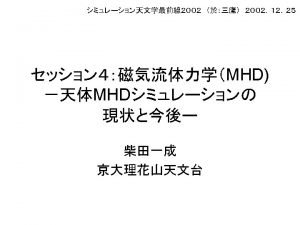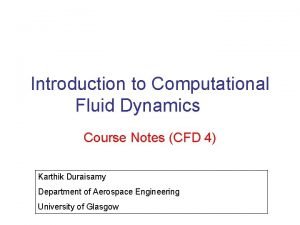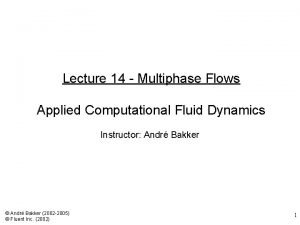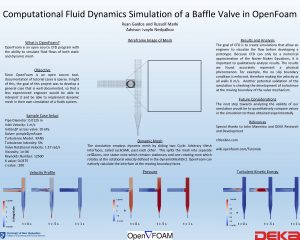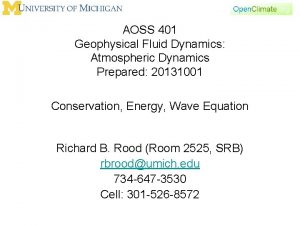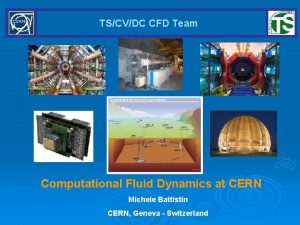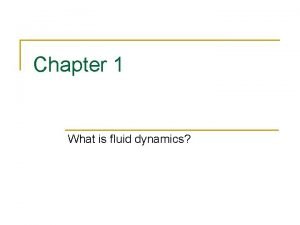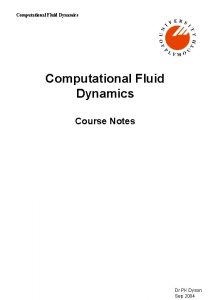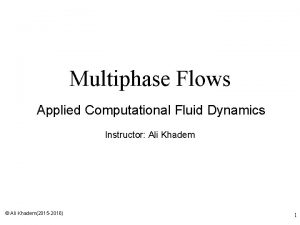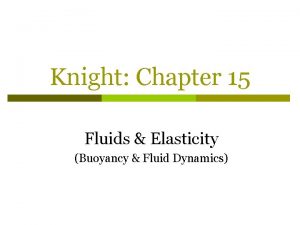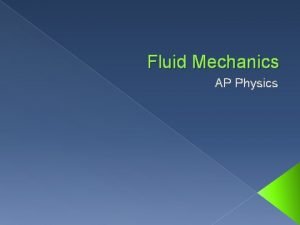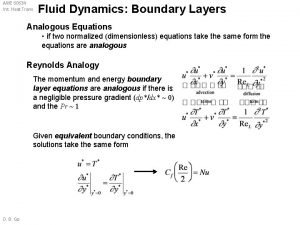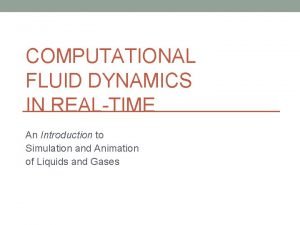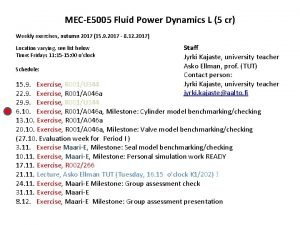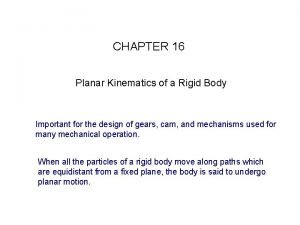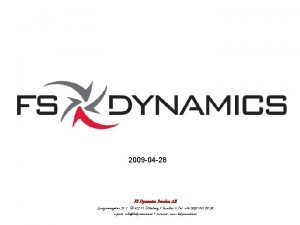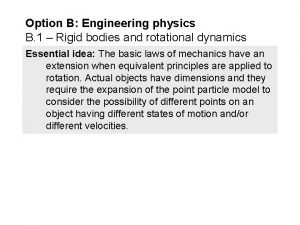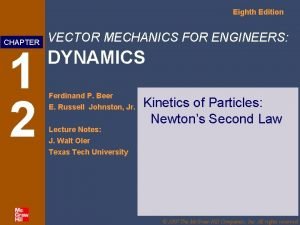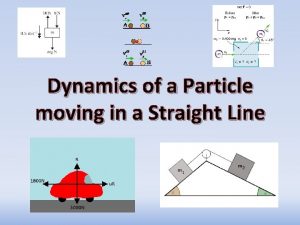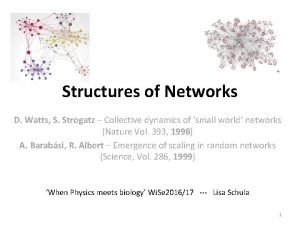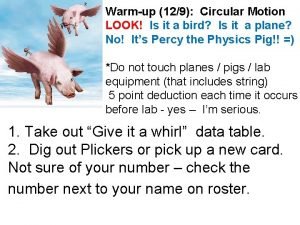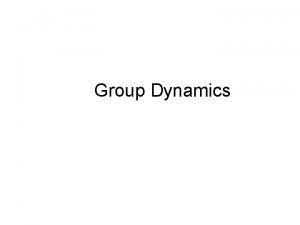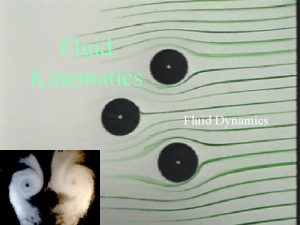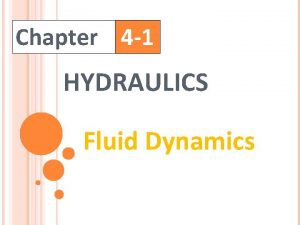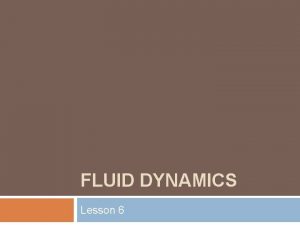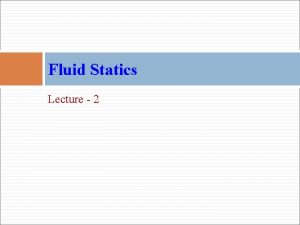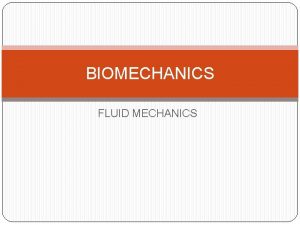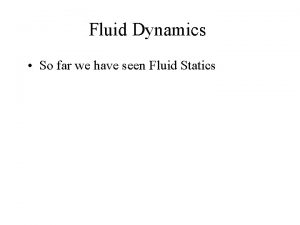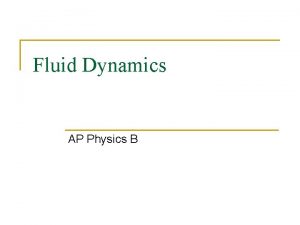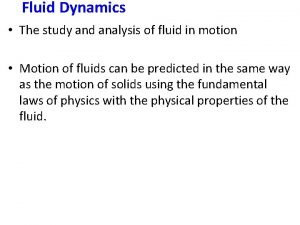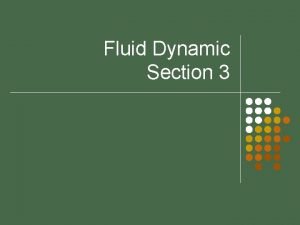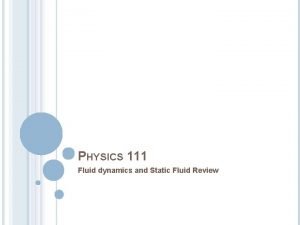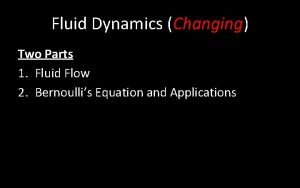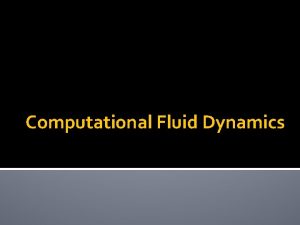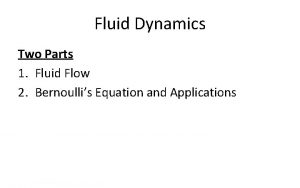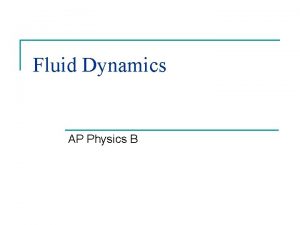Astrophysical Fluid Dynamics What is a Fluid I











































































- Slides: 75

Astrophysical Fluid Dynamics

What is a Fluid ?

I. What is a fluid ? I. 1 The Fluid approximation: The fluid is an idealized concept in which the matter is described as a continuous medium with certain macroscopic properties that vary as continuous function of position (e. g. , density, pressure, velocity, entropy). That is, one assumes that the scales l over which these quantities are defined is much larger than the mean free path �of the individual particles that constitute the fluid, Where n is the number density of particles in the fluid and s is a typical interaction cross section. 4

I. What is a fluid ? Furthermore, the concept of local fluid quantities is only useful if the scale l on which they are defined is much smaller than the typical macroscopic lengthscales L on which fluid properties vary. Thus to use the equations of fluid dynamics we require Astrophysical circumstances are often such that strictly speaking not all criteria are fulfilled. 4

I. What is a fluid ? Astrophysical circumstances are often such that strictly speaking not all fluid criteria are fulfilled. Mean free path astrophysical fluids (temperature T, density n): 1) Sun (centre): fluid approximation very good 2) Solar wind: fluid approximation does not apply, plasma physics 3) Cluster: 4 fluid approximation marginal

Solid vs. Fluid By definition, a fluid cannot withstand any tendency for applied forces to deform it, in such a way that volume is left unchanged. Such deformation may be resisted, but no prevented. A B C D Solid Before application of shear A B C D D C After shear force is removed Shear force A B Fluid C D 5

Mathematical Preliminaries

Mathematical preliminaries Gauss's Law Stoke's Theorem 6

Lagrangian vs. Eulerian View There is a range of different ways in which we can follow the evolution of a fluid. The two most useful and best known ones are: 1) Eulerian view Consider the system properties Q – density, flow velocity, temperature, pressure – at fixed locations. The temporal changes of these quantities is therefore followed by partial time derivative: 2) Lagrangian view Follow the changing system properties Q as you flow along with a fluid element. In a way, this “particle” approach is in the spirit of Newtonian dynamics, where you follow the body under the action of external force(s). The temporal change of the quantities is followed by means of the “convective” or “Lagrangian” derivative

Lagrangian vs. Eulerian View Consider the change of a fluid quantity at a location 1) Eulerian view: change in quantity Q in interval � t, at location : 2) Lagrangian view: change in quantity Q in time interval � t, while fluid element moves from to Convective/ Lagrangian Derivative

Basic Fluid Equations

Conservation Equations To describe a continuous fluid flow field, the first step is to evaluate the development of essential properties of the mean flow field. To this end we evaluate the first 3 moment of the phase space distribution function , corresponding to five quantities, For a gas or fluid consisting of particles with mass m, these are 1) mass density 2) momentum density 3) (kinetic) energy density Note that we use to denote the bulk velocity at location r, and for the particle velocity. The velocity of a particle is therefore the sum of the bulk velocity and a “random” component , In principle, to follow the evolution of the (moment) quantities, we have to follow the evolution of the phase space density. The Boltzmann equation describes this Evolution.

Boltzmann Equation In principle, to follow the evolution of these (moment) quantities, we have to follow the evolution of the phase space density. This means we should solve the Boltzmann equation, The righthand collisional term is given by in which is the angle � -dependent elastic collision cross section. On the lefthand side, we find the gravitational potential term, which according to the Poisson equation is generated by selfgravity as well as the external mass distribution .

Boltzmann Equation To follow the evolution of a fluid at a particular location x, we follow the evolution of a quantity � (x, v) as described by the Boltzmann equation. To this end, we integrate over the full velocity range, If the quantity is a conserved quantity in a collision, then the righthand side of the equation equals zero. For elastic collisions, these are mass, momentum and (kinetic) energy of a particle. Thus, for these quantities we have, The above result expresses mathematically the simple notion that collisions can not contribute to the time rate change of any quantity whose total is conserved in the collisional process. For elastic collisions involving short-range forces in the nonrelativistic regime, there exist exactly five independent quantities which are conserved: mass, momentum and (kinetic) energy of a particle,

Boltzmann Moment Equations When we define an average local quantity, for a quantity Q, then on the basis of the velocity integral of the Boltzmann equation, we get the following evolution equations for the conserved quantities � , For the five quantities the resulting conservation equations are known as the 1) 2) 3) mass density momentum density energy density continuity equation Euler equation energy equation In the sequel we follow – for reasons of insight – a slightly more heuristic path towards inferring the continuity equation and the Euler equation.

Continuity equation n To infer the continuity equation, we consider the conservation of mass contained in a volume V which is fixed in space and enclosed by a surface S. S The mass M is V The change of mass M in the volume V is equal to the flux of mass through the surface S, LHS: RHS, using the divergence theorem (Green’s formula): Where is the outward pointing normal vector.

Continuity equation Since this holds for every volume, this relation is equivalent to n S The continuity equation expresses - mass conservation AND - fluid flow occurring in a continuous fashion !!!!! One can also define the mass flux density as which shows that eqn. I. 1 is actually a continuity equation V

Continuity Equation & Compressibility From the continuity equation, n we find directly that , Of course, the first two terms define the Lagrangian derivative, so that for a moving fluid element we find that its density changes according to In other words, the density of the fluid element changes as the divergence of the velocity flow. If the density of the fluid cannot change, we call it an incompressible fluid , for which.

Momentum Conservation When considering the fluid momentum, , via the Boltzmann moment equation, we obtain the equation of momentum conservation, Decomposing the velocity vi into the bulk velocity ui and the random component wi, we have By separating out the trace of the symmetric dyadic w iwk, we write

Momentum Conservation By separating out the trace of the symmetric dyadic w iwk, we write where P is the “gas pressure” � ik is the “viscous stress tensor” we obtain the momentum equation, in its conservation form,

Momentum Conservation Momentum Equation Describes the change of the momentum density in the i-direction: The flux of the i-th component of momentum in the k-th direction consists of the sum of 1) a mean part: 2) random part I, isotropic pressure part: 3) random part II, nonisotropic viscous part:

Force Equation Momentum Equation By invoking the continuity equation, we may also manipulate the momentum equation so that it becomes the force equation

Viscous Stress A note on the viscous stress term : For Newtonian fluids: Hooke’s Law states that the viscous stress where is linearly proportional to the rate of strain is the shear deformation tensor, The parameters �and �are called the shear and bulk coefficients of viscosity. ,

Euler equation In the absence of viscous terms, we may easily derive the equation for the conservation of momentum on the basis of macroscopic considerations. This yields the Euler equation. As in the case for mass conservation, consider an arbitrary volume V, fixed in space, and bounded by a surface S, with an outward normal. Inside V, the total momentum for a fluid with density and flow velocity is The momentum inside V changes as a result of three factors: 1) External (volume) force, a well known example is the gravitational force when V embedded in gravity field. 2) The pressure (surface) force over de surface S of the volume. (at this stage we'll ignore other stress tensor terms that can either be caused by viscosity, electromagnetic stress tensor, etc. ): 3) The net transport of momentum by in- and outflow of fluid into and out of V

Euler equation 1) External (volume) forces, : where is the force per unit mass, known as the body force. An example is the gravitational force when the volume V is embeddded in a gravitational field. 2) The pressure (surface) force is the integral of the pressure (force per unit area) over the surface S, 3) The momentum transport over the surface area can be inferred by considering at each surface point the slanted cylinder of fluid swept out by the area element � S in time � t, where � S starts on the surface S and moves with the fluid, ie. with velocity. The momentum transported through the slanted cylinder is so that the total transported monetum through the surface S is:

Euler equation Taking into account all three factors, the total rate of change of momentum is given by The most convenient way to evaluate this integral is by restricting oneself to the i-component of the velocity field, Note that we use the Einstein summation convention for repeated indices. Volume V is fixed, so that Furthermore, V is arbitrary. Hence,

Euler equation Reordering some terms of the lefthand side of the last equation, leads to the following equation: From the continuity equation, we know that the second term on the LHS is zero. Subsequently, returning to vector notation, we find the usual exprssion for the Euler equation, Returning to vector notation, and using the we find the usual expression for the Euler equation:

Euler equation An slightly alternative expression for the Euler equation is In this discussion we ignored energy dissipation processes which may occur as a result of internal friction within the medium and heat exchange between its parts (conduction). This type of fluids are called ideal fluids. Gravity: For gravity the force per unit mass is given by where the Poisson equation relates the gravitational potential �to the density � :

Euler equation From eqn. (I. 4) we see that the LHS involves the Lagrangian derivative, so that the Euler equation can be written as In this form it can be recognized as a statement of Newton’s 2 nd law for an inviscid (frictionless) fluid. It says that, for an infinitesimal volume of fluid, mass times acceleration = total force on the same volume, namely force due to pressure gradient plus whatever body forces are being exerted.

Energy Conservation In terms of bulk velocity and random velocity the (kinetic) energy of a particle is, The Boltzmann moment equation for energy conservation becomes � Expanding the term inside the spatial divergence, we get �

Energy Conservation Defining the following energy-related quantities: 1) specific internal energy: 2) “gas pressure” 3) conduction heat flux � 4) viscous stress tensor �

Energy Conservation The total energy equation for energy conservation in its conservation form is This equation states that the total fluid energy density is the sum of a part due to bulk motion and a part due to random motions. The flux of fluid energy in the k-th direction consists of 1) the translation of the bulk kinetic energy at the k-th component of the mean velocity, 2) plus the enthalpy – sum of internal energy and pressure – flux, 3) plus the viscous contribution 4) plus the conductive flux

Work Equation Internal Energy Equation For several purposes it is convenient to express energy conservation in a form that involves only the internal energy and a form that only involves the global Pd. V work. The work equation follows from the full energy equation by using the Euler equation, by multiplying it by and using the continuity equation: Subtracting the work equation from the full energy equation, yields the internal energy equation for the internal energy where �is the rate of viscous dissipation evoked by the viscosity stress

Internal energy equation If we use the continuity equation, we may also write the internal energy equation in the form of the first law of thermodynamics, in which we recognize as the rate of doing Pd. V work, and as the time rate of adding heat (through heat conduction and the viscous conversion of ordered energy in differential fluid motions to disordered energy in random particle motions).

Energy Equation On the basis of the kinetic equation for energy conservation we may understand that the time rate of the change of the total fluid energy in a volume V (with surface area A), i. e. the kinetic energy of fluid motion plus internal energy, should equal the sum of 1) minus the surface integral of the energy flux (kinetic + internal) 2) plus surface integral of doing work by the internal stresses Pik 3) volume integral of the rate of doing work by local body forces (e. g. gravitational) 4) minus the heat loss by conduction across the surface A 5) plus volumetric gain minus volumetric losses of energy due to local sources and sinks (e. g. radiation)

Energy Equation The total expression for the time rate of total fluid energy is therefore � Pik is the force per unit area exerted by the outside on the inside in the i th direction across a face whose normal is oriented in the k th direction. For a dilute gas this is æ �is the energy gain per volume, as a result of energy generating processes. æ �is the energy loss per volume due to local sinks (such as e. g. radiation)

Energy Equation By applying the divergence theorem, we obtain the total energy equation:

Heat Equation Implicit to the fluid formulation, is the concept of local thermal equilibrium. This allows us to identify the trace of the stress tensor Pik with thermodynamic pressure p, Such that it is related to the internal energy per unit mass of the fluid, and the specific entropy s, by the fundamental law of thermodynamics , Applying this thermodynamic equation and subtracting the work equation (see relevant slide 64), we obtain the Heat Equation, where �equals the rate of viscous dissipation,

Fluid Flow Visualization

Flow Visualization: Streamlines, Pathlines & Streaklines Fluid flow is characterized by a velocity vector field in 3 -D space. There are various distinct types of curves/lines commonly used when visualizing fluid motion: streamlines, pathlines and streaklines. These only differ when the flow changes in time, ie. when the flow is not steady ! If the flow is not steady, streamlines and streaklines will change. 1) Streamlines re a Family of curves that are instantaneously tangent to the velocity vector . They show the direction a fluid element will travel at any point in time. If we parameterize one particular streamline then streamlines are defined as , with ,

Flow Visualization: Streamlines Definition Streamlines: Illustrations of streamlines … If the components of the streamline can be written as and then re a

2) Pathlines Flow Visualization: Pathlines are the trajectories that individual fluid particles follow. These can be thought of as a "recording" of the path a fluid element in the flow takes over a certain period. The direction the path takes will be determined by the streamlines of the fluid at each moment in time. Pathlines are defined by re a where the suffix P indicates we are following the path of particle P. Note that at location the curve is parallel to velocity vector location at time t. , where the velocity vector is evaluated at

3) Streaklines Flow Visualization: Streaklines are the locus of points of all the fluid particles that have passed continuously through a particular spatial point in the past. Dye steadily injected into the fluid at a fixed point extends along a streakline. In other words, it is like the plume from a chimney. Streaklines where re a can be expressed as is the velocity at location parameterizes the streakline and at time t. The parameter with t 0 time of interest.

Flow Visualization: Streamlines, Pathlines, Streaklines The following example illustrates the different concepts of streamlines, pathlines and streaklines: �red: pathline �blue: streakline �short-dashed: evolving streamlines re a

Steady flow is a flow in which the velocity, density and the other fields do not depend explicitly on time, namely In steady flow streamlines and streaklines do not vary with time and coincide with the pathlines.

Kinematics of Fluid Flow

Stokes’ Flow Theorem Stokes’ flow theorem: The most general differential motion of a fluid element corresponds to a 1) 2) 3) 4) uniform translation uniform expansion/contraction uniform rotation distortion (without change volume) divergence term vorticity term shear term The fluid velocity at a point Q displaced by a small amount from a point P will differ by a small amount, and includes the components listed above: Divergence uniform expansion/contraction uniform translation Vorticity uniform rotation Shear term distortion

Stokes’ Flow Theorem Stokes’ flow theorem: the terms of the relative motion wrt. point P are: 2) Divergence term: uniform expansion/contraction 3) Shear term: uniform distortion : shear deformation scalar : shear tensor 4) Vorticity Term: uniform rotation

Stokes’ Flow Theorem Stokes’ flow theorem: One may easily understand the components of the fluid flow around a point P by a simple Taylor expansion of the velocity field around the point P: Subsequently, it is insightful to write the rate-of-strain tensor terms of its symmetric and antisymmetric parts: in The symmetric part of this tensor is the deformation tensor, and it is convenient -and insightful – to write it in terms of a diagonal trace part and the traceless shear tensor ,

Stokes’ Flow Theorem where 1) the symmetric (and traceless) shear tensor 2) the antisymmetric tensor is defined as as 3) the trace of the rate-of-strain tensor is proportional to the velocity divergence term,

Stokes’ Flow Theorem Divergence Term We know from the Lagrangian continuity equation, that the term represents the uniform expansion or contraction of the fluid element.

Stokes’ Flow Theorem Shear Term The traceless symmetric shear term, represents the anisotropic deformation of the fluid element. As it concerns a traceless deformation, it preserves the volume of the fluid element (the volume-changing deformation is represented via the divergence term). intention is for the volume of the sphere and the ellipsoid to be equal

Stokes’ Flow Theorem Shear Term Note that we can associate a quadratic form – ie. an ellipsoid – with the shear tensor, the shear deformation scalar S, such that the corresponding shear velocity contribution is given by We may also define a related quadratic form by incorporating the divergence term, Evidently, this represents the irrotational part of the velocity field. For this reason, we call the velocity potential:

Stokes’ Flow Theorem Vorticity Term The antisymmetric term, represents the rotational component of the fluid element’s motion, the vorticity. With the antisymmetric we can associate a (pseudo)vector, the vorticity vector where the coordinates of the vorticity vector, the vorticity tensor via where , are related to is the Levi-Cevita tensor, which fulfils the useful identity

Stokes’ Flow Theorem Vorticity Term The contribution of the antisymmetric part of the differential velocity therefore reads, The last expression in the eqn. above equals the i-th component of the rotational velocity of the fluid element wrt to its center of mass, so that the vorticity vector can be identified with one-half the angular velocity of the fluid element,

Linear Momentum Fluid Element The linear momentum of a fluid element equal the fluid velocity over the mass of the element, integrated Substituting this into the equation for the fluid flow around P, we obtain: If P is the center of mass of the fluid element, then the 2 nd and 3 rd terms on the RHS vanish as Moreover, for the 4 th term we can also use this fact to arrive at,

Linear Momentum Fluid Element Hence, for a fluid element, the linear momentum equals the mass times the center-of-mass velocity,

Angular Momentum Fluid Element With respect to the center-of-mass P, the instantaneous angular momentum of a fluid element equals We rotate the coordinate axes to the eigenvector coordinate system of the deformation tensor (or, equivalently, the shear tensor ), in which the symmetric deformation tensor is diagonal and all strains Then are extensional,

Angular Momentum Fluid Element In the eigenvalue coordinate system, the angular momentum in the 1 -direction is where with algebra we obtain where and evaluated at the center-of-mass P. After some is the moment of inertia tensor Notice that is not diagonal in the primed frame unless the principal axes of happen to coincide with those of.

Angular Momentum Fluid Element Using the simple observation that the difference since the isotropic part of does not enter in the difference, we find for all 3 angular momentum components with a summation over the repeated l’s. Note that for a solid body we would have For a fluid an extra contribution arises from the extensional strain if the principal axes of the moment-of-inertia tensor do not coincide with those of. Notice, in particular, that a fluid element can have angular momentum wrt. its center of mass without possesing spinning motion, ie. even if !

Inviscid Barotropic Flow

Inviscid Barotropic Flow In this chapter we are going to study the flow of fluids in which we ignore the effects of viscosity. In addition, we suppose that the energetics of the flow processes are such that we have a barotropic equation of state Such a replacement considerably simplifies many dynamical discussions, and its formal justification can arise in many ways. One specific example is when heat transport can be ignored, so that we have adiabatic flow, with s the specific entropy per mass unit. Such a flow is called an isentropic flow. However, barotropic flow is more general than isentropic flow. There also various othermodynamic circumstances where the barotropic hypothesis is valid.

Inviscid Barotropic Flow For a barotropic flow, the specific enthalpy h becomes simply and

Kelvin Circulation Theorem Assume a fluid embedded in a uniform gravitational field, i. e. with an external force so that – ignoring the influence of viscous stresses and radiative forces - the flow proceeds according to the Euler equation, To proceed, we use a relevant vector identity which you can most easily check by working out the expressions for each of the 3 components. The resulting expression for the Euler equation is then

Kelvin Circulation Theorem If we take the curl of equation we obtain where is the vorticity vector, and we have used the fact that the curl of the gradient of any function equals zero, Also, a classical gravitational field satisfies this property, so that gravitational fields cannot contribute to the generation or destruction of vorticity.

Vorticity Equation In the case of barotropic flow, ie. if so that also the 2 nd term on the RHS of the vorticity equation disappears, The resulting expression for the vorticity equation for barotropic flow in a conservative gravitational field is therefore, which we know as the Vorticity Equation.

Kelvin Circulation Theorem Interpretation of the vorticity equation: Compare to magnetostatics, where we may associate the value of with a certain number of magnetic field lines per unit area. With such a picture in mind, we may give the following geometric interpretation of magnetic field lines per unit area. With such a Picture, we may give the following geometric interpretation of the vorticity equation, which will be the physical essence of the Kelvin Circulation Theorem The number of vortex lines that thread any element of area, that moves with the fluid , remains unchanged in time for inviscid barotropic flow.

Kelvin Circulation Theorem To prove Kelvin’s circulation theorem, we define the circulation �around a circuit C by the line integral, Transforming the line integral to a surface integral over the enclosed area A by Stokes’ theorem, we obtain This equation states that the circulation �of the circuit C can be calculated as the number of vortex lines that thread the enclosed area A.

Kelvin Circulation Theorem Time rate of change of � Subsequently, we investigate the time rate of change of �if every point on C moves at the local fluid velocity. Take the time derivative of the surface integral in the last equation. It has 2 contributions: where is the unit normal vector to the surface area. The time rate of change of area can be expressed mathematically with the help of the figure illustrating the change of an area A moving locally with fluid velocity. On the basis of this, we may write, We then interchange the cross and dot in the triple scalar product

Kelvin Circulation Theorem Time rate of change of � Using Stokes’ theorem to convert the resulting line integral to a surface integral, we obtain: The vorticity equation tells us that the integrand on the right-hand side equals zero, so that we have the geometric interpretation of Kelvin’s circulation theorem,

Kelvin Circulation Theorem Time rate of change of � Using Stokes’ theorem to convert the resulting line integral to a surface integral, we obtain: The vorticity equation tells us that the integrand on the right-hand side equals zero, so that we have the geometric interpretation of Kelvin’s circulation theorem,

the Bernoulli Theorem Closely related to Kelvin’s circulation theorem we find Bernoulli’s theorem. It concerns a flow which is steady and barotropic, i. e. and Again, using the vector identity, we may write the Euler equation for a steady flow in a gravitational field �

the Bernoulli Theorem The Euler equation thus implies that where h is the specific enthalpy, equal to for which We thus find that the Euler equation implies that

the Bernoulli Theorem The Euler equation thus implies that where h is the specific enthalpy, equal to for which We thus find that the Euler equation implies that

the Bernoulli Theorem Defining the Bernoulli function B which has dimensions of energy per unit mass. The Euler equation thus becomes Now we consider two situations, the scalar product of the equation with and , 1) B is constant along streamlines this is Bernoulli’s streamline theorem 2) B is constant along vortex lines ie. along integral curves * vortex lines are curves tangent to the vector field
 Arcetri astrophysical observatory
Arcetri astrophysical observatory Astrophysical journal keywords
Astrophysical journal keywords Euler's equation fluid mechanics
Euler's equation fluid mechanics Cfd lecture notes
Cfd lecture notes Computational fluid dynamics
Computational fluid dynamics Efdc
Efdc Fluid dynamics
Fluid dynamics Computational fluid dynamics
Computational fluid dynamics Openfoam baffle
Openfoam baffle Geophysical fluid dynamics
Geophysical fluid dynamics Computational fluid dynamics
Computational fluid dynamics Fluid dynamics definition
Fluid dynamics definition Sutherland's law
Sutherland's law Computational fluid dynamics
Computational fluid dynamics Computational fluid dynamics
Computational fluid dynamics Fluid dynamics
Fluid dynamics Fluid dynamics
Fluid dynamics Fluid dynamics
Fluid dynamics Real time fluid dynamics for games
Real time fluid dynamics for games Fluid power dynamics
Fluid power dynamics Hypoosmotic
Hypoosmotic Fluid statics deals with fluid at rest
Fluid statics deals with fluid at rest Timeline fluid mechanics
Timeline fluid mechanics Total body water
Total body water Extracellular fluid and interstitial fluid
Extracellular fluid and interstitial fluid Synovial membrane
Synovial membrane Bioimpedância
Bioimpedância Paracentesis for ascites
Paracentesis for ascites P1-p2
P1-p2 Planar kinematics of a rigid body
Planar kinematics of a rigid body Section 1 population dynamics answer key
Section 1 population dynamics answer key Clone record dynamics 365 on premises
Clone record dynamics 365 on premises Datacenterdynamics
Datacenterdynamics Weather dynamics definition
Weather dynamics definition Microsoft dynamics seminar
Microsoft dynamics seminar Module 62 ap psychology
Module 62 ap psychology Fs dynamics sweden ab
Fs dynamics sweden ab Connect power bi desktop to dynamics 365
Connect power bi desktop to dynamics 365 Team dynamics france
Team dynamics france Mechanics dynamics aesthetics examples
Mechanics dynamics aesthetics examples Deep change spiritual intelligence assessment
Deep change spiritual intelligence assessment Dynamics of rigid bodies
Dynamics of rigid bodies Vector mechanics for engineers: dynamics
Vector mechanics for engineers: dynamics Office automation microsoft dynamics gp
Office automation microsoft dynamics gp Human systems dynamics
Human systems dynamics Vasp aimd
Vasp aimd Dynamics of a particle moving in a straight line
Dynamics of a particle moving in a straight line Https //www.microsoft.com/link
Https //www.microsoft.com/link Dynamics 365 backup veeam
Dynamics 365 backup veeam Dynamics nav memphis
Dynamics nav memphis Fundamental attribution error
Fundamental attribution error Dynamics 365 industrial equipment manufacturing
Dynamics 365 industrial equipment manufacturing Social integration and influence in group dynamics
Social integration and influence in group dynamics Dynamics
Dynamics Classroom dynamics examples
Classroom dynamics examples Gamification dynamics
Gamification dynamics Managing global competitive dynamics
Managing global competitive dynamics Circular dynamics
Circular dynamics Fifteen
Fifteen Engaging dynamics
Engaging dynamics Generate eft file dynamics gp
Generate eft file dynamics gp Terraced dynamics music definition
Terraced dynamics music definition Collective dynamics of small world networks
Collective dynamics of small world networks Dynamics 365 security best practices
Dynamics 365 security best practices Security permissions in smartview for dynamics gp
Security permissions in smartview for dynamics gp Ib group 4 project
Ib group 4 project Selling dynamics 365
Selling dynamics 365 Conflict dynamics profile
Conflict dynamics profile Formula for centripetal acceleration in circular motion
Formula for centripetal acceleration in circular motion Microsoft dynamics wholesale
Microsoft dynamics wholesale Rigid body dynamics
Rigid body dynamics Types of group dynamics
Types of group dynamics Cultural dynamics in assessing global markets
Cultural dynamics in assessing global markets çağatay başdoğan
çağatay başdoğan Chapter 4 section 1 population dynamics
Chapter 4 section 1 population dynamics Dynamics gp miami
Dynamics gp miami

